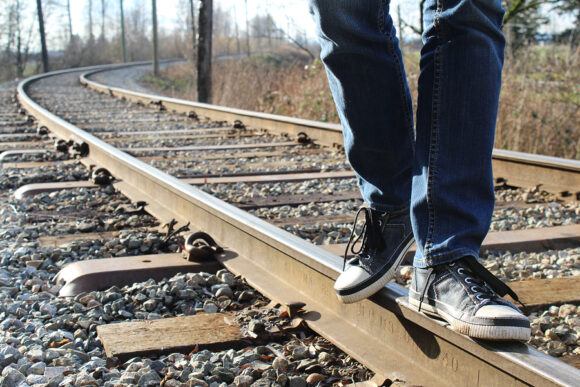Around midnight on May 30, 2012, Mary Gaffney, 17, was struck and killed by a freight train in Riverdale Park, Md. She was taking a shortcut through a residential area and may have been wearing earphones when a CSX freight train approached rapidly from behind.
 She was the fourth person killed walking on the nation’s railroad tracks that day. The others were killed in San Mateo, Calif., and the suburbs of Chicago and St. Louis.
She was the fourth person killed walking on the nation’s railroad tracks that day. The others were killed in San Mateo, Calif., and the suburbs of Chicago and St. Louis.
What even federal regulators could not see because of how these accidents were reported was that Mary was the fourth pedestrian in less than three years to die on the same stretch of tracks.
Pedestrian railroad accidents typically receive little attention, despite being the leading cause of death on the rails. Since 1997 more than 7,200 pedestrians have been fatally struck and 6,400 have been injured by trains in the U.S.
Despite about 500 deaths each year, railroad companies across the country often refuse to take even small steps to deal with the problem, a St. Louis Post-Dispatch investigation found.
“Railroads don’t want any legal exposure, so they don’t accept any responsibility,” said Harvey Levine, a former vice president of the Association of American Railroads, who toward the end of his career with the trade group became alarmed by the industry’s safety record.
To the railroads, the solution is simple: “The incidents would have been avoided if the persons were not trespassing on railroad property,” Union Pacific spokesman Mark Davis said.
It took years of effort to tackle what was once the leading killer on the railroad: highway grade crossings. Following a public outcry in the early 1970s, hundreds of millions of taxpayer dollars were spent to fortify crossings with flashing lights and automatic gates. The result: Crossing accidents have plummeted 80 percent.
But state and federal officials mostly lack powers to require safety improvements to stop people from walking on the tracks. In fact, many states have stricter rules on keeping livestock off the rails than people, leading to the odd scenario where a railroad could be liable for a fatality if it’s a calf, but not a child.
A few years ago, the Federal Railroad Administration asked the railroads for internal trespassing reports to get a better sense of who was walking on the tracks. The railroads refused, and the agency recently conceded defeat.
For years, the agency required railroads to report only the county of a death or injury, making it hard to identify hot spots for trespassing, said Ron Ries, director of the agency’s Highway-Rail Grade Crossing Safety and Trespass Prevention Division.
In 2008, the agency pushed to require GPS coordinates. The industry objected. But five unions representing railroad workers and state railroad regulators supported the move. And in June 2011, the new federal rule on GPS coordinates took effect. But at least four more years of the data are needed before researchers can even begin to identify trespassing hot spots, says the FRA.
In the meantime, even travel through places with known trespassing risks does not affect track speed limits, which are set by the FRA. Sometimes, even what is happening directly on the tracks doesn’t seem to matter.
After two girls were killed on a trestle in Kent, Wash., an Amtrak supervisor testified in 2003 that trains operate with an “inherent right” to go the posted track speed. In that case, the Amtrak engineer had been warned five minutes before the crash by a passing freight train that two girls were playing up ahead.
As the train bore down, the girls, one of whom had cerebral palsy, were running to get off the trestle. With a track limit of 80 mph, the train slowed from 79 to 65 mph, according to court records. The emergency brakes were never applied. Rachel Marturello, 11, and Zandra Lafley, 13, died a few feet from safety.
Asked recently about the Kent case, a spokesman said all Amtrak engineers operate in compliance with federal regulations.
Education is one way to address the trespassing problem, say railroads and regulators. That happens mostly through Operation Lifesaver, a national nonprofit that spreads the message about rail safety. But, the railroad industry is giving less money to state groups and providing fewer employees to help, documents show.
Illinois and Kansas have increased the number of presentations in recent years. But dramatic declines were reported in Missouri, Ohio, New Jersey, Florida, California and Maryland, according to 2002-2010 data submitted to the national office of Operation Lifesaver.
Joyce Rose, national president, acknowledged the loss of railroad workers, but said the organization remains active “even with all the funding challenges,” reaching an average of 1 million people each year since 2005.
Another tool is trespassing arrests. But the railroads employ relatively few police officers and many local police agencies are already spread thin.
The third tool is engineering – restricting access to the tracks using things like fences or overpasses.
Railroads dismiss fencing because, they say, people determined to cross will do it, such as in cases of suicide. They also respond that they can’t fence the entire system. “It’s impractical to do that,” said Robin Chapman, a spokesman for Norfolk Southern.
This is a popular sentiment echoed across the industry. But the call for fencing is along known problem areas. “That is not the same as fencing in 10,000 miles of track,” said David Clarke, director at the University of Tennessee’s Transportation Research Center.
In Villa Park, Ill., it took a young teen to get a fence built. By age 15, Tiffany Davis had lost two friends in two years to the tracks in this small Chicago suburb.
Trackside memorials dot the rails, including a wood cross marking the spot where a middle school student was killed and two others injured as they walked home from school years ago.
Today, a black, metal rail fence runs along stretches of the tracks, paid for with railroad and public funds. And it seems to be doing its job, local officials say.
Villa Park police officer William Lyons, who investigates train accidents, boasted this fall that it had been 18 months since someone died on the tracks in his town.
It was the longest such streak in years.
Was this article valuable?
Here are more articles you may enjoy.


 J&J Talc Jury Awards $1.56 Billion to Asbestos Cancer Victim
J&J Talc Jury Awards $1.56 Billion to Asbestos Cancer Victim  ‘Door Knocker’ Roofers Were Everywhere. NC Farm Bureau Saw an Opportunity
‘Door Knocker’ Roofers Were Everywhere. NC Farm Bureau Saw an Opportunity  Marijuana’s Move to Schedule III: What it Really Means for Cannabis Insurance
Marijuana’s Move to Schedule III: What it Really Means for Cannabis Insurance  Cat Bonds Linked to Wildfires Lose ‘Once Untouchable’ Status
Cat Bonds Linked to Wildfires Lose ‘Once Untouchable’ Status 